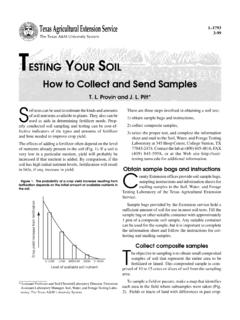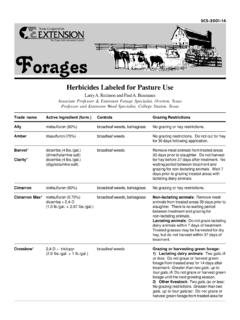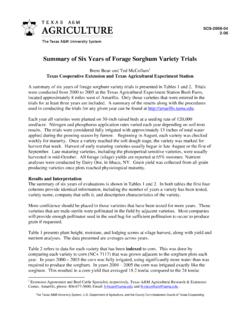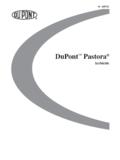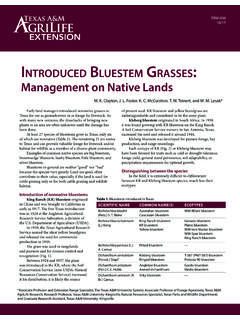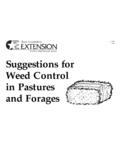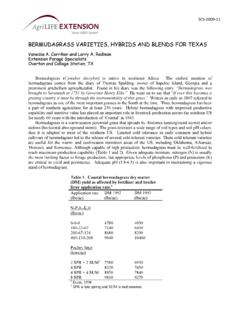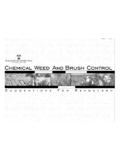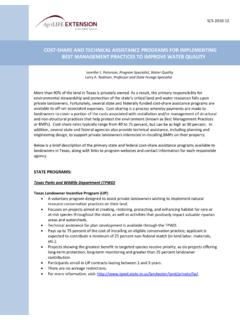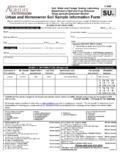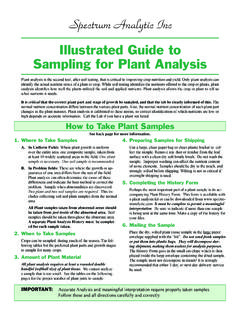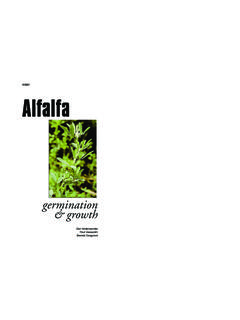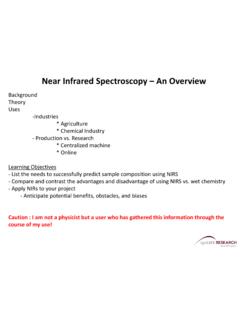Transcription of Nitrates and Prussic Acid in Forages
1 L-5433. 1-03. Nitrates and Prussic acid in Forages Sampling, Testing and Management Strategies Provin and Pitt*. When Nitrates and Prussic acid accumulate in forage, the feed may not be safe for livestock consumption. N. Nitrates 2. When the soil contains nitrate nitrogen but little soil moisture, Nitrates are highly concentrated in the water plants take up. plants don't have enough water nitrate accumulation to continue growing and Nitrates accumulate. Ammonium nitrogen is the preferred form of nitrogen for plant growth, but nitrate nitrogen is the form primarily 3.
2 Herbicide injury can limit the conversion and assimi- taken up by plants . Even when ammonium and urea- lation of Nitrates in plants . After herbicide applica- based fertilizers are applied, most of the nitrogen taken up tions, check the field, especially field edges, for for- by plants is in the nitrate form because soil microorgan- age plants affected by off-target herbicide drift. isms quickly convert ammonium nitrogen to nitrate nitro- gen (See Texas Cooperative Extension publication E-59, Three to 5 days of active growth are needed to signifi- What Happens to Nitrogen in Soils?)
3 Nitrates are cantly reduce nitrate levels in plants . extremely soluble in water and are easily absorbed by plant roots along with soil moisture. Nitrates often accumulate to toxic levels in the follow- ing plants : Normally, plants reduce Nitrates to ammonium ions and then assimilate them into amino acids and other pro- Forages Weeds teins. This process, called nitrate reductase, occurs in the roots of some grasses such as bermudagrass, and in the alfalfa Canada thistle leaves, stems and stalks of plants such as corn or sorghum.
4 Barley dock species When plants are stressed (for example, by drought) this process slows or stops, allowing Nitrates to accumulate. corn jimsonweed flax johnsongrass Here are some conditions that cause nitrate accumula- millet kochia tion: oats lambsquarters 1. When the temperature is high and moisture is ade- rape nightshade species quate, plants may undergo a process called pho- rye pigweed torespiration. Photorespiration produces carbon dioxide rather than assimilating carbon into energy soybean Russian thistle building blocks ( , sugars, carbohydrates, etc.)
5 This sorghum and sorghum hybrids smartweed may cause Nitrates to accumulate. sudangrass sunflower species sugarbeets *Assistant Professor and Extension Soil Chemist and Extension Associate, The Texas A&M University System While these plants are the ones most likely to accumu- limit-grazing corn, sorghum, sorghum-sudangrass and sim- late Nitrates , Nitrates are present to some degree in all for- ilar Forages , sample only the plant leaves. ages, including bermudagrasses. Nitrates are nonvolatile and remain in nonensiled plants after cutting, curing and When rotational grazing or single-field grazing sys- baling.
6 Nitrates are soluble in plant tissues and will leach tems are used, a more conservative sampling approach is from the plant during sustained rainfall. However, weath- warranted because livestock will consume not just the ering significantly reduces the nutritional value of hay leaves and upper plant parts but also the stems (which bales so it is not a good way to manage Nitrates . contain more nitrate ). Take the lower one-third to one-half Furthermore, the movement of leached Nitrates within a of traditional grasses, small grains and legumes for nitrate weathered bale may limit the use of the forage.
7 Analysis, and the lower one-third of corn stalks, sorghum and sorghum-sudangrass stalks. Research at the Texas Veterinary Medical Diagnostic Laboratory (TVMDL) at Texas A&M University has found To sample standing forage, create a composite sample that it is safe to feed forage containing 1 percent nitrate from plant parts taken from at least 10 to 15 areas with the (on a dry-matter basis) to healthy ruminants. Forage with same fertility and moisture conditions. Do not mix plants a higher percentage of nitrate could be fed if it is ground from good and bad parts of the field.
8 Create different and mixed with nitrate -free forage to reduce overall nitrate composite samples for these areas. Ship samples to the levels to less than 1 percent (dry-matter basis). Forage con- laboratory in clean paper sacks. Do not use plastic bags taining to 1 percent nitrate should not be fed to weak- because the high moisture content will cause the samples ened cattle unless your veterinarian has approved it. The 1 to mold, which interferes with the nitrate analysis. percent nitrate level set by the TVMDL is significantly high- er than levels suggested by other southern universities.
9 To sample forage in bales, take representative core sam- This level assumes that cattle are healthy, well conditioned, ples with a bale probe. This is the only sampling method and being fed a high-energy diet. that will adequately evaluate the average nitrate levels in the bale, but this method can not be used for sampling In healthy cattle, the nitrate consumed in normal for- coarse-stemmed forage such as corn, sorghum, sorghum- ages is converted into protein in the rumen: sudangrass or similar plants unless the bale will be ground before it is fed.
10 To sample a bale of coarse-stemmed forage, nitrate nitrite ammonia amino acids proteins split the bale open and collect the lower stems of individ- ual plants to ensure that the highest possible nitrate level is revealed by the analysis. This will guard against timid Symptoms of nitrate poisoning animals consuming too much nitrate (in the lower stems). If forage contains too much nitrate the animals cannot because the leaves and more palatable upper stems were complete the conversion and nitrite levels build up.
